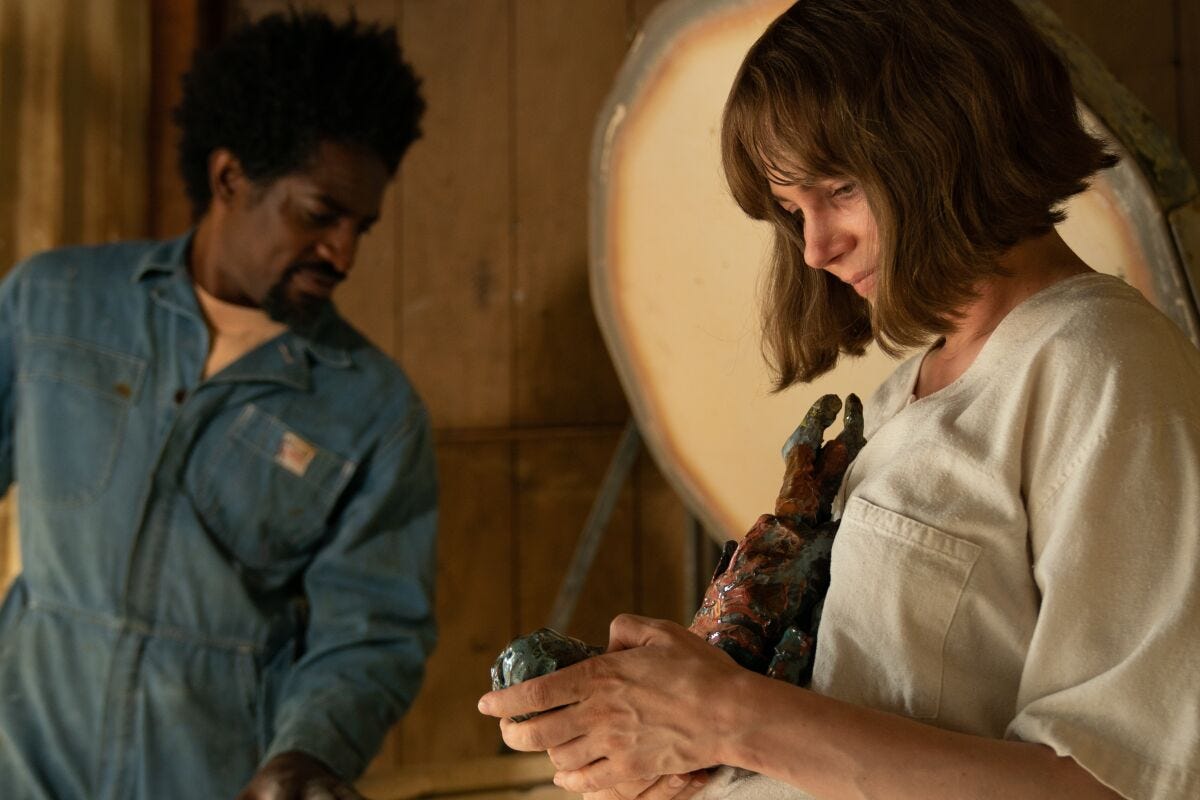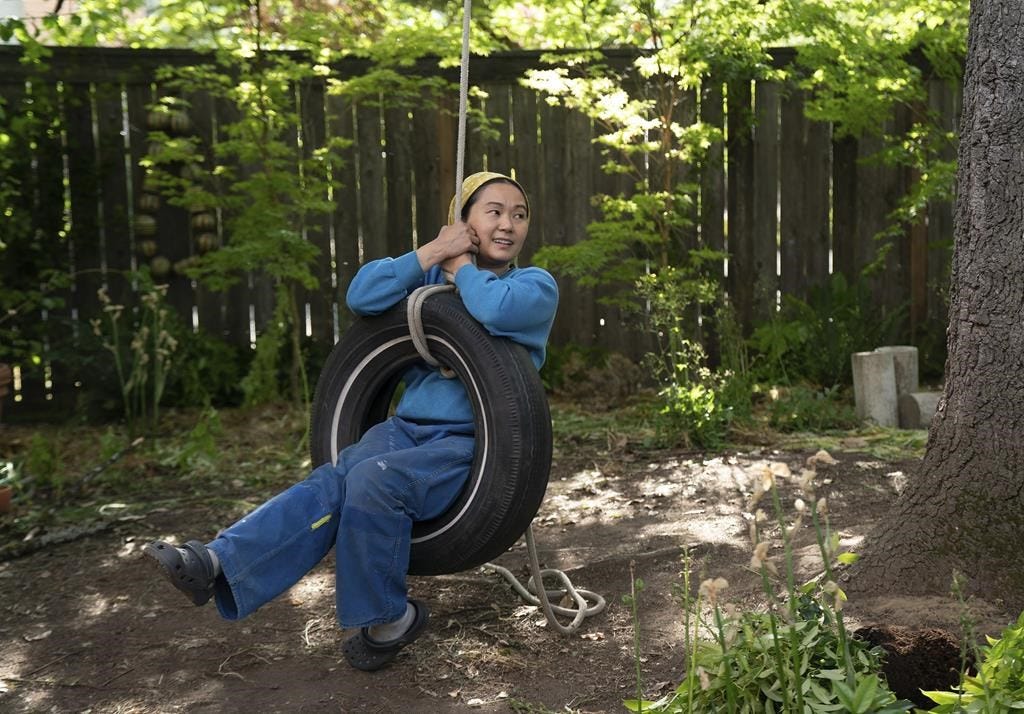SHOWING UP is Enough
Kelly Reichardt's new movie about art, the creative process, and nursing birds back to health.
Kelly Reichardt’s eighth feature film is her lightest fare yet. A master filmmaker who revels in stillness and open spaces has removed almost all stakes in her latest story. There’s no friendships to save (Old Joy), no wagon brigade to lead to safety (Meek’s Cutoff), no hostage situation or potential loves or marriage in trouble (Certain Women), nor is there a cow’s milk to risk your life for (First Cow). There is merely another week to live, and a deadline to meet.
Michelle Williams, starring in her fourth Reichardt film, plays Lilly, a Portland ceramicist and art college administrative assistant who strains to feed her cat and struggles to convince her landlord and fellow deadline-working artist Jo (Hong Chau) to fix her broken water heater. At the film’s close, Lilly will have hosted a show, and what happens before then is a meandering walk of a plot. There’s seemingly nothing more interesting to Reichardt and co-writer Jon Raymond, who have collaborated on several of Reichardt’s films now. Rather than ride a roller coaster or resolve a major tension, we are here to observe and ponder process.
There are similarities between Lilly and Reichardt, and additionally Cynthia Lahti, the real artist behind the sculptures that Williams is tasked with “creating” in the movie. These are artists who are successful ever-working, but outside of major commercial interests and successes and “fame”, working in smaller markets (i.e. Portland, OR), and living regular lives surrounded by other artists. The specifics of the similarities may end there, as filmmaking, a massively collaborative art, and sculpting, a completely individual art, lie on different ends of a creative spectrum. It is that entire spectrum that this movie is, successfully I think, speaking to, in broad strokes and in fine. Sitting down to your craft every day and doing the work of it; shaping your creative output to fit in the modern demands of a capitalist society; losing sleep, losing social time, losing your perfect vision to the restrictions and uncontrollables of process and the real world. There are ideas and themes here that I believe can and will resonate with anyone who creates anything, “successful” or not.
Reichardt loves a still frame and long scenes of few people doing simple things, and this story is perfect for her cinematic interests. Her typical filmmaking sharpness is here, with great work by cinematographer Chris Blauvelt, and when movies are this still, the editing really takes center-stage as the plot mover and pacemaker. Reichardt has edited almost all of her own films, and she really has a punch and an expertise on that front, choosing wisely when to hold, or when to jump in, or when to jump over to the next day.
While being her lightest film on plot, it is also her funniest. I never thought Reichardt would make a theaterfull of people laugh out loud every ten minutes, but that’s what she achieved in my showing. Several performances in particular bring levity to the screen, especially Lilly’s parents Jean (Maryann Plunkett) and Bill (Judd Hirsch), who are separated yet local. Just as in Steven Spielberg’s THE FABLEMANS, Hirsch is only with us for a handful of minutes, but brings wonderful dramatic heft when he arrives to view his daughter’s latest work, a wordless scene that nearly brought me to tears. André Benjamin, a.k.a. Andre 3000, gives a warm and human performance as Eric, a pottery teacher and the heat-treater for Lilly’s sculptures. Chau serves as an object of frustration as the “more successful” neighbor to be coveted, but is impossibly charming underneath while giving a bizarre and hilarious physical performance. And Williams, at the center of it all, is her usual focused and quiet self, able to successfully show us the comedy and mundanity and frustrations of creating art and getting by.
In an interview given many years ago, Reichardt said her films are about people who don’t have safety nets. That has continued to be the case ever since, and plays another large role here, especially in the life of Lilly’s brother Sean, played sympathetically by First Cow lead John Magaro. Sean lives alone, dines alone, doesn’t seem to have a job, and also exists on the artistic spectrum, creating “earth pieces”.
After spending 90 minutes poking around the quiet streets of Portland, the film peaks in a final ten minute set piece of middling family drama and the film’s only escalation towards tension, in the form of a pigeon, before fading into another classic Kelly Reichardt ending; one that continues the idea of levity and warmth.
“You have to listen to what’s not being said”, Sean tells his sister as they loiter in his backyard. “Many people choose not to listen.” Showing Up is a quiet movie, a sparse narrative. But it has a lot to say, and a lot to give, if you choose to hear it.
I had the wonderful opportunity to see this movie several days in advance at Cinema 21, where co-writer Jon Raymond once worked at as a young man, and who was there at the movie to do a Q&A with the film’s real central sculptor Cynthia Lahti. They had a wonderful discussion, and I got to ask them about the experience(s) of not just making art, but having it adapted, as they have both been by Reichardt now (Jon’s novels, Cynthia’s sculptures).
This is my favorite movie of the year (so far), and I hope you give it a chance. It’s not the high-octance thrill that typically draws people out of their homes, but it’s a soothing and nourishing watch, and I’m glad I’ve had it.
What else has been soothing or nourishing for you this week? What has been high-octane entertainment? Or worse, what have you given your time to that kinda sucked (I’m looking at you, the Miami Heat play-in tournament performance)? Chime in here, or there, or wherever you can and do find me.
TTFN,
B





